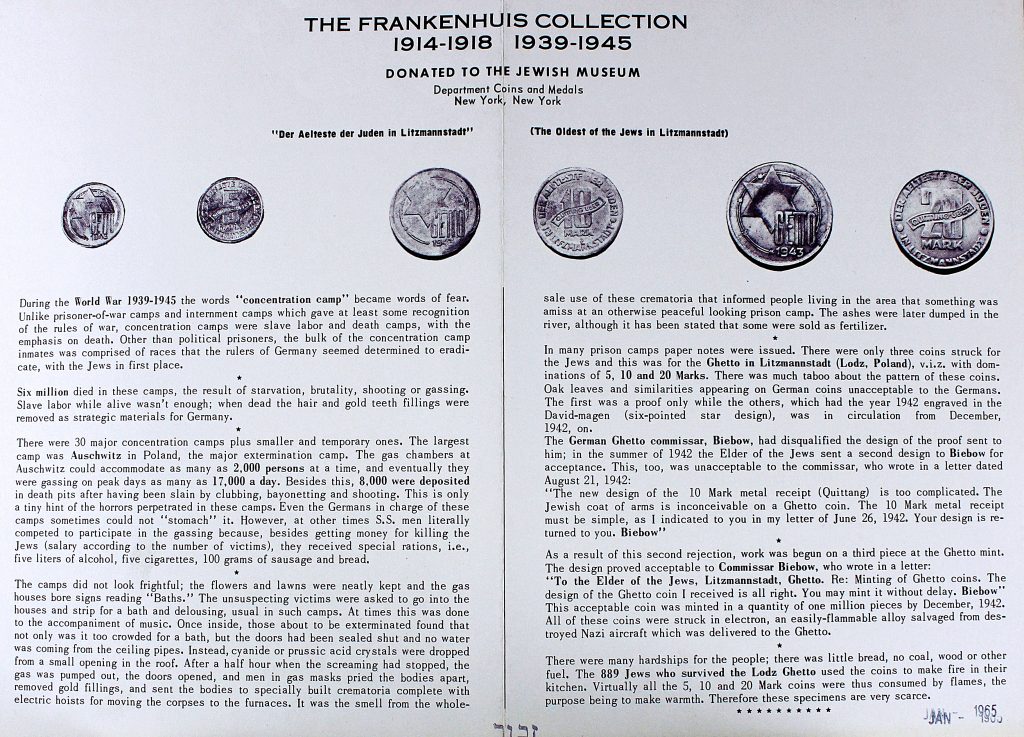The Jewish Museum (New York)
Lodz Ghetto coins donated to Jewish Museum in New York, 1965

“Der Aelteste der Juden in Litzmannstadt”
(The Oldest of the Jews in Litzmannstadt)
During the World War 1939-1945 the words “concentration camp” became words of fear. Unlike prisoner-of-war camps and internment camps which gave at least some recognition of the rules of war, concentration camps were slave labor and death camps, with the emphasis on death. Other than political prisoners, the bulk of the concentration camp inmates was comprised of races that the rulers of Germany seemed determined to eradi-
cate, with the Jews in first place.
Six million died in these camps, the result of starvation, brutality, shooting or gassing. Slave labor while alive wasn’t enough; when dead the hair and gold teeth fillings were removed as strategic materials for Germany.
There were 30 major concentration camps plus smaller and temporary ones. The largest camp was Auschwitz in Poland, the major extermination camp. The gas chambers at Auschwitz could accommodate as many as 2,000 persons at a time, and eventually they were gassing on peak days as many as 17,000 a day. Besides this, 8,000 were deposited in death pits after having been slain by clubbing, bayoneting and shooting. This is only a tiny hint of the horrors perpetrated in these camps. Even the Germans in charge of these camps sometimes could not “stomach” it. However, at other times S.S. men literally competed to participate in the gassing because, besides getting money for killing the Jews (salary according to the number of victims), they received special rations, i.e., five liters of alcohol, five cigarettes, 100 grams of sausage and bread.
The camps did not look frightful; the flowers and lawns were neatly kept and the gas houses bore signs reading “Baths.” The unsuspecting victims were asked to go into the houses and strip for a bath and delousing, usual in such camps. At times this was done to the accompaniment of music. Once inside, those about to be exterminated found that not only was it too crowded for a bath, but the doors had been sealed shut and no water was coming from the ceiling pipes. Instead, cyanide or prussic acid crystals were dropped from a small opening in the roof. After a half hour when the screaming had stopped, the gas was pumped out, the doors opened, and men in gas masks pried the bodies apart, removed gold fillings, and sent the bodies to specially built crematoria complete with electric hoists for moving the corpses to the furnaces. It was the smell from the wholesale use of these crematoria that informed people living in the area that something was amiss at an otherwise peaceful looking prison camp. The ashes were later dumped in the river, although it has been stated that some were sold as fertilizer.
In many prison camps paper notes were issued. There were only three coins struck for the Jews and this was for the Ghetto in Litzmannstadt (Lodz, Poland), v.1.2. with denominations of 5, 10 and 20 Marks. There was much taboo about the pattern of these coins Oak leaves and similarities appearing on German coins unacceptable to the Germans.
The first was a proof only while the others, which had the year 1942 engraved in the David-magen (six-pointed star design, was in circulation from December, 1942, on.
The German Ghetto commissar, Biebow, had disqualified the design of the proof sent to him; in the summer of 1942 the Elder of the Jews sent a second design to Biebow for acceptance. This, too, was unacceptable to the commissar, who wrote in a letter dated August 21, 1942:
“The new design of the 10 Mark metal receipt (Quittang) is too complicated. The Jewish coat of arms is inconceivable on a Ghetto coin. The 10 Mark metal receipt must be simple, as I indicated to you in my letter of June 26, 1942. Your design is returned to you. Biebow”
As a result of this second rejection, work was begun on a third piece at the Ghetto mint. The design proved acceptable to Commissar Biebow, who wrote in a letter:
To the Elder of the Jews, Litzmannstadt, Ghetto. Re: Minting of Ghetto coins. The design of the Ghetto coin I received is all right. You may mint it without delay. Biebow”
This acceptable coin was minted in a quantity of one million pieces by December, 1942.
All of these coins were struck in electron, an easily-flammable alloy salvaged from destroyed Nazi aircraft which was delivered to the Ghetto.
There were many hardships for the people; there was little bread, no coal, wood or other fuel. The 889 Jews who survived the Lodz Ghetto used the coins to make fire in their kitchen. Virtually all the 5, 10 and 20 Mark coins were thus consumed by flames, the purpose being to make warmth. Therefore these specimens are very scarce.